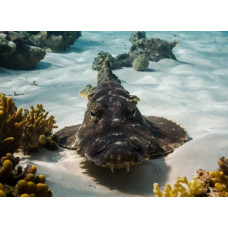Latin name
Orectolobus wardi
Other name
Orectolobus wardi
Identification
Northern Wobbegong have a flattened and broad head and body. The nostrils are framed by unbranched antennae. In front of and below the eyes there are two skin lobes forming a fringe. The blades of the fringe, located behind the spatulae, are broad and unbranched. The tubercles and protuberances on the dorsal surface are absent. The mouth is located in front of the eyes. There is a symphyseal groove on the chin.
Features of fish fins
Dorsal spines (total): 0; Anal spines: 0.
The distance between the dorsal fins of these sharks is longer than the inner edge of the first dorsal fin and equal to half its base. The base of the first dorsal fin is at the level of the last quarter of the bases of the pelvic fins. The height of the first dorsal fin is approximately equal to the length of its base. The caudal fin is asymmetrical, with a ventral notch at the edge of the upper lobe, and the lower lobe is undeveloped.
Fish colouring
The colouration of the Northern Wobbegong is very variegated, although not light and dark. The body is covered with saddle-shaped, rounded markings with bright edges.
Distribution
Northern Wobbegong are endemic to the north coast of Australia and are found off the coasts of Queensland, the Northern Territories and Western Australia.
Habitat
A marine, reef associated species. These sharks are found in tropical coastal waters of the continental shelf at depths of up to 3m.
Size
The maximum recorded length of this species is 63 cm.
Behavior
These sharks are nocturnal, hiding in crevices and caves during the day.
Food and feeding habits
The diet of the northern wobbegong is thought to consist of benthic invertebrates and small fish.
Reproduction
These sharks reproduce by laying eggs. Males reach sexual maturity at a length of 45 cm.
Fishing
The species is of no interest to commercial fisheries. All sharks and rays are protected by law in Western Australian waters.
Relationship with a person
The northern wobbegong is traumatogenic to humans because of its huge teeth.
| Classification | |
| Phylum | Chordata |
| Class | Chondrichthyes |
| Squad | Orectolobiformes |
| Family | Orectolobidae |
| Genus | Orectolobus |
| Species | O. wardi |
| Features | |
| Conservation status | Least Concern |
| Habitat | Pelagic |
| Life span, years | No information |
| Maximum body weight, kg | No information |
| Maximum length, cm | 63 |
| Sailing speed, m/s | No information |
| Threat to people | Not edible |
| Way of eating | Predator |
Northern wobbegong
Tags: northern wobbegong

